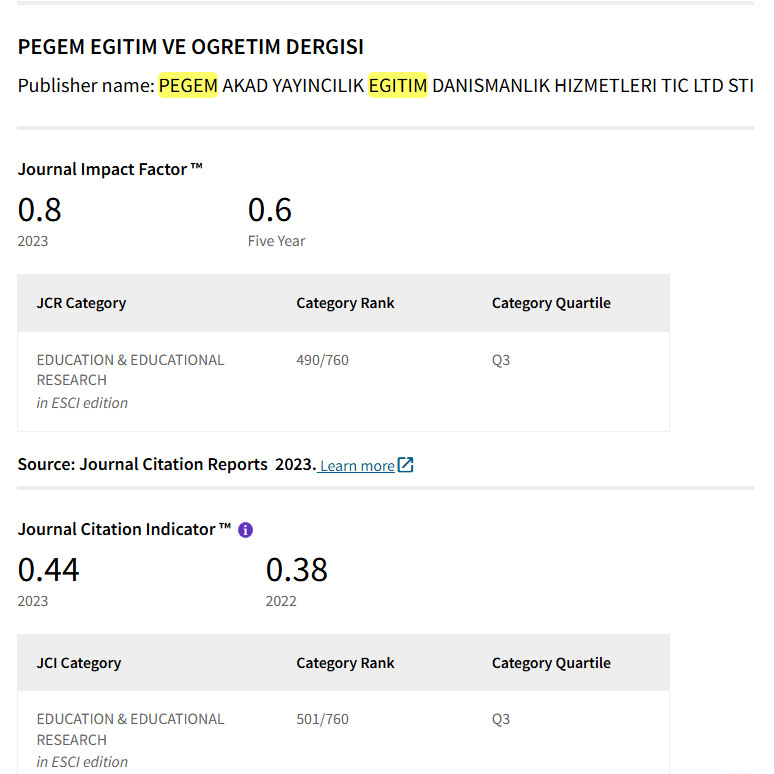Improvement of Student with Intellectual Disability Practice Grasping Skills with a Combination of Fine Motor Games
DOI:
https://doi.org/10.47750/pegegog.14.04.30Keywords:
children with intellectual disability, fine motor, grasping abilityAbstract
Intellectual disability causes inhibition of motor skills development, both fine and gross motor skills. The ability to grip is one of the fine motor skills whose growth is hampered. Lack of grasping ability causes students to be unable to carry out activities, such as cutting, writing, and other daily activities. Even though these activities are needed by all children, including intellectual disability children. Using game learning media, a combination of fine motor skills can train the grasping ability of intellectual disability students. Based on this, the purpose of this study is to determine whether there is an increase in students' fine motor skills, especially grasping, using a combination of fine motor games. The research method uses a Single Subject Research Design. Data collection was carried out in two series with an A-B-A research design. The sample used is one student with mild intellectual disability in grade IV in Special School in Malang Regency who has a poor grasping ability. The results showed that the fine motor skills of holding intellectual disability students increased by 89% using a combination of fine motor game media. From the study results, it can know that there is a significant increase in students' fine motor skills when using a combination of fine motor games. Using a variety of fine motor game media also makes students look excited, motivated, and willing to talk, and when given instructions, they do it right away.
Downloads
References
Atika, M. 2020. Penggunaan Permainan Pasir Kinetik Dalam Meningkatkan Motorik Halus Anak Di TK Solera Desa Balane Kecamatan Kinovaro Kabupaten Sigi. Other thesis, IAIN Palu. Dari http://repository.iainpalu.ac.id/id/eprint/667.
Atmaja, J. R. 2017. Pendidikan Dan Bimbingan Anak Berkebutuhan Khusus. Bandung: Remaja Rosdakarya.
Bratanata, S. A. 1979. Pendidikan Anak Terbelakang Mental, Jakarta: Depdikbud.
Davis, J. L., & Matthews, R. N. (2010). Review of nepsy-second edition (nepsy-ii). Journal of Psychoeducational Assessment, 28(2), 175–182. https://doi.org/10.1177/0734282909346716
Destiyani, J., & DH, D. P. (2019, December). Analisis Perkembangan Motorik Anak Pada Usia 3-4 Tahun. In Seminar Nasional PAUD 2019 (pp. 48-53). Dari http://conference.upgris.ac.id/index.php/Snpaud2019/-article/view/440
Gallahue, D. L., Ozmun, J. C., & Goodway, J. D. (2012). Understanding motor development: Infants, children, adolescents and adults (7th edn.). McGraw-Hill.
Hasanah, N. 2019. Pengaruh Penggunaan Media Video Pembelajaran Terhadap Prestasi Belajar Siswa Kelas VII Pada Mata Pelajaran Fiqih Di MTS Darul Huda Wonodadi Biltar Tahun 2018/2019. Skripsi. Iain Tulungagung. Dari http:-//repo.uinsatu.ac.id/id/eprint/12078.
Ihaka, R. 2005. Time Series Analysis. Lecture Notes: Statistic Department University of Auckland.
Jalil, A. 2019. Pengembangan Media Permainan Lego Huruf pada Anak Usia Dini. S1 thesis, Pascasarjana. Universitas negeri Makassar. Dari http://eprints.unm.ac.id/id/eprint/12626.
Kementerian Pendidikan dan Kebudayaan Republik Indonesia. 2014. Lampiran 1 Tentang Standar Nasional Pendidikan Anak Usia Dini. Jakarta. Dari repositori.kemdikbud.go.id/12860/1/Permendikbud No. 137 Tahun 2014 - SN-PAUD.pdf
Khoiriyyah U.H.K. 2019. Pengaruh Permainan Puzzle Angka terhadap Kemampuan Kognitif Anak Kelompok B di TK Kusuma Mulia Ngadiluwih Kediri Tahun Ajaran 2018/2019. Skripsi, UIN SATU Tulungagung. Dari http://repo.uinsatu.ac.id/id/eprint/13862.Kementerian Pendidikan dan Kebudayaan Republik Indonesia. 2014. Lampiran 1 Tentang Standar Nasional Pendidikan Anak Usia Dini. Jakarta. Dari repositori.kemdikbud.go.id/12860/1/Permendikbud No. 137 Tahun 2014 - SN-PAUD.pdf
Korkman, M., Kirk, U., & Kemp, S. (2007). Nepsy—second edition (nepsy-ii). Harcourt Assessment.
Mutia, M., & Iswari, M. 2020. Meningkatkan Motorik Halus Melalui Lego Dasar Bagi Anak Tunagrahita. Ranah Research: Journal Of Multidisciplinary Research And Development, 2(2), 73-80. Dari https://-jurnal.ranahresearch.com/index.php/R2J/article/view/237.
Oktaviana, D. 2017. Pengaruh Media Pembelajaran Puzzle Subtema Ketampakan Rupa Bumi Terhadap Partisipasi dan Prestasi Belajar Siswa Kelas III di SD Negeri 1 Rancamaya. Bachelor Thesis, Universitas Muhammadiyah Purwokerto. Dari http://repository.ump.ac.id/-id/eprint/3937.
Pakpahan, et al. 2020. Pengembangan Media Pembelajaran. Medan: Kita Menulis.
Puspitasari, T., Susilo, B., & Coastera, F. F. 2016. Implementasi Metode Dempster-Shafer Dalam Sistem Pakar Diagnosa Anak Tunagrahita Berbasis Web. Rekursif: Jurnal Informatika, 4(1). Dari https://ejournal-.unib.ac.id/index.php/rekursif/article/download/949/794.
Rahyubi, H. 2012. Teori-Teori Belajar Dan Aplikasi Pembelajaran Motorik. Majalengka: Referens Publishing.
Shree, A., & Shukla P. C. 2016. Intellectual Disability: Definition, Classification, Causes, And Characteristics. International Journal Of Education And Social Development.
Sugiyono. 2016. Metode Penelitian Kuantitatif Kualitatif Dan R&D. Bandung: Alfabeta.
Sujiono, B., Sumantri, M. S., & Chandrawati, T. (2014). Hakikat Perkembangan Motorik Anak. Modul Metod. Pengemb. Fis, 1-21. Dari https://www.academia.edu/download/56289394/PGTK2302-M1.pdf
Sunanto, J., et al. 2005. Pengantar Penelitian Dengan Subyek Tunggal. Criced University Of Tsukuba.
Sundayana, R. 2014. Statistika Penelitian Pendidikan. Bandung: Alfabeta.
Usengül, L., & Bahçeci, F. (2020). The Effect of LEGO WeDo 2.0 Education on Academic Achievement and Attitudes and Computational Thinking Skills of Learners toward Science. World Journal of Education, 10(4), 83-93.
Waty, A. K. (2019). Efektivitas Media Pom-Pom dalam Metode Bermain untuk Meningkatkan Kemampuan Berhitung pada Usia 4-5 Tahun (Kelompok A). ThufuLA: Jurnal Inovasi Pendidikan Guru Raudhatul Athfal, 7(1), 1-14. Dari http://dx.doi.org/10.21043/thufula.v7i1.4720.
Yosefa, V. 2021. Pengaruh Keterampilan Meronce Terhadap Motorik Halus Anak Tunagrahita Ringan Kelas III di SDLB Bhakti Luhur Cabang Jember. Speed Journal: Journal Of Special Education, 4(2), 40-44. Dari https://doi.org/10.31537/speed.v4i2.400.
Downloads
Published
How to Cite
Issue
Section
License
Copyright (c) 2024 Pegem Journal of Education and Instruction

This work is licensed under a Creative Commons Attribution-NonCommercial 4.0 International License.
Attribution — You must give appropriate credit, provide a link to the license, and indicate if changes were made. You may do so in any reasonable manner, but not in any way that suggests the licensor endorses you or your use.
NonCommercial — You may not use the material for commercial purposes.
No additional restrictions — You may not apply legal terms or technological measures that legally restrict others from doing anything the license permits.



